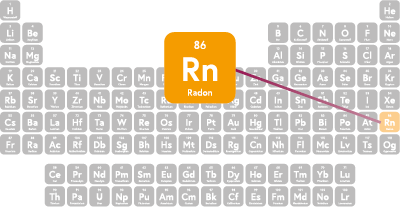What is radon?
The naturally occurring noble gas radon is formed by radioactive decay from uranium and is itself radioactive. Radon can accumulate in buildings under unfavorable conditions, where it is constantly inhaled. It is not perceptible to the human senses. Nevertheless, it can be easily measured.
Since radon is formed during the radioactive decay of uranium and uranium is present in almost all soils, radon is also formed everywhere. As a gas, it can pass with the soil air through cracks and crevices in the foundation and thus into the indoor air. Under unfavorable conditions, very high radon concentrations can thus occur in buildings. To protect the health of those people who stay in these buildings, such a situation should be avoided by precaution or remediation.
Since radon only becomes a problem when it accumulates in indoor air in buildings, it is a technologically related indoor pollutant. Outdoors, there is generally a strong dilution, so that no radon concentrations of concern occur.
Why is radon dangerous?
The World Health Organization (WHO) classifies radon and its derivatives as a proven carcinogen. Radon is thus on the same level as tobacco smoke and asbestos. In addition, radon is the largest contributor to the average radiation exposure of humans in Austria. After smoking, radon is the most frequent cause of lung cancer! In people who have never smoked, radon is even the most common cause of this type of cancer. According to current knowledge, other health complaints are not caused by radon.
Strictly speaking, the radon secondary products lead, polonium and bismuth are responsible for the harmful radiation exposure. As a gas, radon remains in the respiratory tract only briefly and is quickly exhaled. The radon progenies, however, remain in the moist respiratory tract. The radon secondary products can damage cells in the lung tissue and thus lead to lung cancer.
